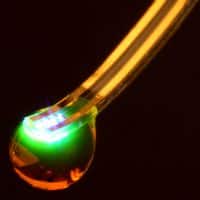Researchers at the Washington University School of Medicine (Missouri, USA), and University of Illinois (Illinois, USA), created a remote controlled, next-generation tissue implant that allows neuroscientists to inject drugs and shine lights on neurons deep inside the brains of mice, which enabled the team to wirelessly determine the path a mouse walks with a press of a button. With a thickness of 80 micrometers and a width of 500 micrometers, the optofluidic implant is thinner than the metal tubes (cannulas) that scientists typically use to inject drugs, thus resulting in less implant damage and brain tissue displacement. The scientists tested the device’s drug delivery potential by surgically placing it into the brains of mice. In some experiments, they showed that they could precisely map circuits by using the implant to inject viruses that label cells with genetic dyes. In other experiments, they made mice walk in circles by injecting a drug that mimics morphine into the ventral tegmental area (VTA), a region that controls motivation and addiction. The researchers also tested the device’s combined light and drug delivery potential when they made mice that have light-sensitive VTA neurons stay on one side of a cage by commanding the implant to shine laser pulses on the cells. The mice lost the preference when the scientists directed the device to simultaneously inject a drug that blocks neuronal communication. In all of the experiments, the mice were about three feet away from the command antenna. Reporting that: “We demonstrate these devices in freely moving animals to modify gene expression, deliver peptide ligands, and provide concurrent photostimulation with antagonist drug delivery to manipulate mesoaccumbens reward-related behavior,” the study authors submit that. “The minimally invasive operation of these probes forecasts utility in other organ systems and species, with potential for broad application in biomedical science, engineering, and medicine.”
Futuristic Brain Probe Controls Neurons
Jeong JW, McCall JG, Shin G, Zhang Y, Al-Hasani R, Kim M, Li S, Sim JY, Jang KI, Shi Y, Hong DY, Liu Y, Schmitz GP, Xia L, He Z, Gamble P, Ray WZ, Huang Y, Bruchas MR, Rogers JA. “Wireless Optofluidic Systems for Programmable In Vivo Pharmacology and Optogenetics.” Cell. 2015 Jul 14. pii: S0092-8674(15)00828-4.
RELATED ARTICLES




